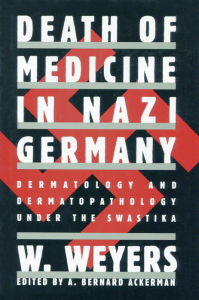Death of Medicine in Nazi Germany
Dermatology and Dermatopathology under the Swastika
Ardor Scribendi, Philadelphia 1998
Der Aufstieg der Nationalsozialisten hat die Dermatologie wie kein anderes medizinisches Fachgebiet beeinflusst. Der wichtigste Grund dafür war die hohe Zahl jüdischer Ärzte in der Dermatologie, der eine „Arisierung“ aus der Sicht der Nazis besonders vordringlich erscheinen ließ. Anhand persönlicher Schicksale aus dem Bereich der Dermatologie werden die Umgestaltung der Gesellschaft unter nationalsozialistischer Herrschaft, die Veränderungen in medizinischer Ethik, Forschung und Praxis, die zunehmende Unterdrückung, Krieg und Massenvernichtung sowie die unmittelbare Nachkriegszeit beschrieben.
Über
Aufstieg und Fall des Nationalsozialismus betrachtet durch das Fenster der Dermatologie – diese Perspektive ist deshalb besonders aufschlussreich, weil sich die Nationalsozialisten selbst als Ärzte verstanden (mit dem therapeutischen Ziel der Wiederherstellung der Volksgesundheit durch Vernichtung lebensunwerten Lebens und Förderung der Vermehrung rassisch wertvoller Individuen), weil Geschlechtskrankheiten diese „Therapie“ behindern konnten und weil der Anteil jüdischer Ärzte in der Dermatologie größer war als in allen anderen medizinischen Fachgebieten. In zehn Kapiteln werden die Geschichte des Antisemitismus, die Wirren der Weimarer Republik, die Umgestaltung der Gesellschaft unter nationalsozialistischer Herrschaft, die Veränderungen in medizinischer Ethik, Forschung und Praxis, die zunehmende Unterdrückung, Krieg und Massenvernichtung sowie die unmittelbare Nachkriegszeit beschrieben – illustriert anhand persönlicher Schicksale aus dem Bereich der Dermatologie und optisch unterstützt durch fast 400 Abbildungen. Durchzogen wird diese Erzählung von der Frage nach den Optionen persönlichen Verhaltens unter schwierigsten Bedingungen, eine Frage, die den Blick schärft für das Für und Wider eigener Entscheidungen unter den ungleich günstigeren Bedingungen der Gegenwart.
Kommentare zum Buch
The death of Medicine in Nazi Germany is an important book, timely, well written, well researched, beautifully illustrated, and with it all, a fascinating read. I recommend it highly.
John S. Crissey, Dermatopathology: Practical and Conceptual 1998; 4: 369-371.
Dr. Weyers has written a seminal, analytic history of German medicine during the years 1933-1945, and he describes with clarity the behavior of the German medical profession to Jewish colleagues, in particular, dermatologists. He also writes painstakingly and heartwrenchingly of their fate. The book is organized in a logical and scholarly manner. I recommend this book to dermatologists, other physicians, and interested lay persons with enthusiasm. It is fascinating reading – and much more.
Michael J. Franzblau, Dermatopathology: Practical and Conceptual 1998; 4: 371-372.
Weyers’s documentary account takes the reader through a “Who’s Who“ of medicine in the 19th and 20th centuries. … This book should be required reading, because it recalls the tragedy of German medicine during a time when prejudices and hatred overcame reason, let alone the Hippocratic oath.
Lawrence C. Parish, New England Journal of Medicine 1999; 340: 1931.
What makes this volume so unusual is its meticulous scholarship, coupled with the absolute integrity of a contemporary German gazing courageously at his own roots. He proceeds as might a forensic pathologist, dissecting the unconscionable behavior of the guilty, while dispassionately exploring both the roots and insidious progress of National Socialism. Rather than look at the problems of National Socialism in the usual historical or psychosocial context, Dr. Weyers examines the practice of medicine under the Nazis. Medicine may be the most appropriate filter through which to review the National Socialist phenomenon because the Nazis saw themselves as physicians to the German people.
Peter M. Elias, Archives of Dermatology 1999; 135: 1132-1135.
Wolfgang Weyers, a dermatopathologist in Freiburg, Germany, has performed a splendid service both for medicine and for his own specialty. … Weyers chronicles the careers of all the prominent dermatologists during the Nazi period. This is a substantial contribution to medical history. We learn about the physicians’ discoveries and achievements and their subsequent professional lives. The outstanding doctors who were dismissed from their jobs or hounded out of Germany are thereby not forgotten. This history is accompanied by numerous photographs and an extensive and detailed glossary of dermatologic terminology and concepts. … This book deserves a wide reading among dermatologists and other physicians.
Hannah S. Decker, Journal of the American Medical Association 2000; 283: 1486-1487.
Dr. Weyers’ monumental and unforgettable study contains biographical sketches of hundreds of physicians, many of whom are well-known, a myriad of previously little-known facts and statistics, nearly 400 pictures and illustrations, and 50 pages of detailed footnotes, references and indices. It is painful to read Death of Medicine in Nazi Germany; nonetheless, it should be required reading for every physicians and medical student.
Leonard Berlin, Chicago Medicine 2000; 104: 27-29.
Wolfgang Weyers’ Death of Medicine in Nazi Germany not only remembers, but places before us in compelling and dispassionate language, as if echoing the cool impersonal words that sent millions to their deaths, an eloquent human testimonial to an obscene moment in history. … Dr. Weyers leads us along, step by step and page by tragic page, each anecdote and personality an escalation built upon those that came before, to a crescendo which no one who has read this book is likely to forget. The fascination lies in the details, both of personality and of incident. … Dr. Weyers has included numerous photographs, which dramatically complement the text. Most arresting, however, are the portraits, the names of many of whom still grace the textbooks of our time as a result of their work. In these images we see the actual face of a moment in time when decisions and choices of an almost intolerable sort had to be made by real people. The faces are the faces of ourselves, and they ask us who we are, and what we would stand for. This is a book that not only every physician should read, but a book for everyone who reads.
Charles E. Moore, Journal of the American Academy of Dermatology 2001; 44: 318-319.
